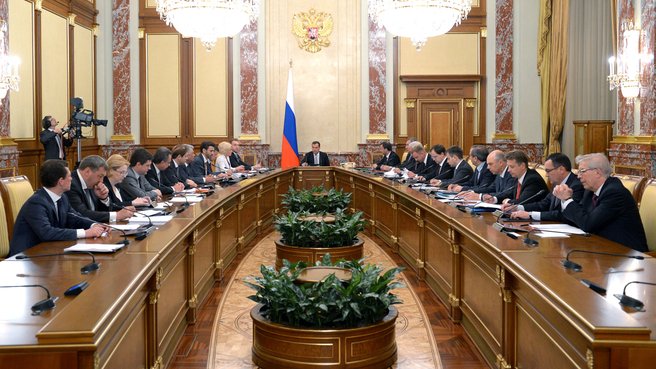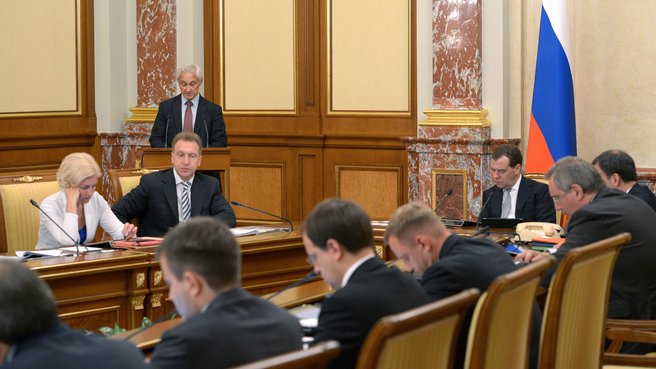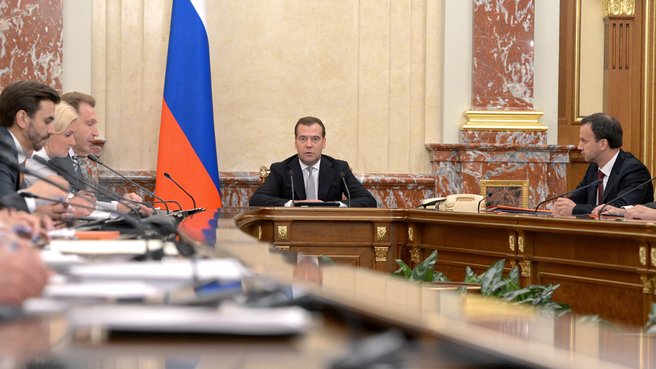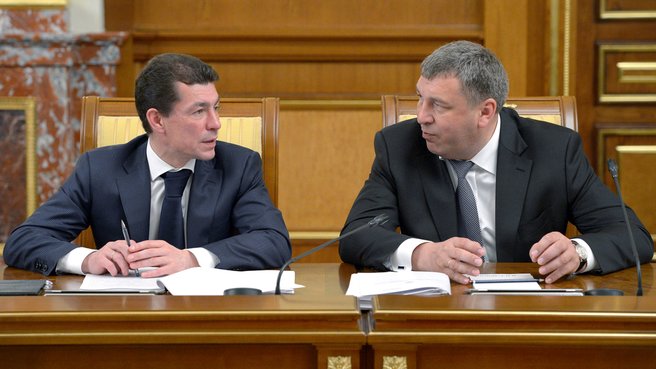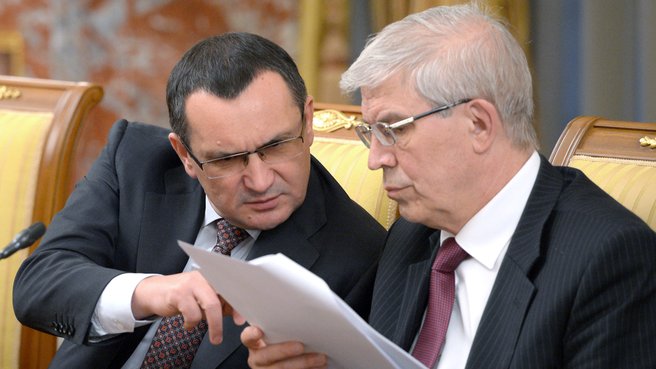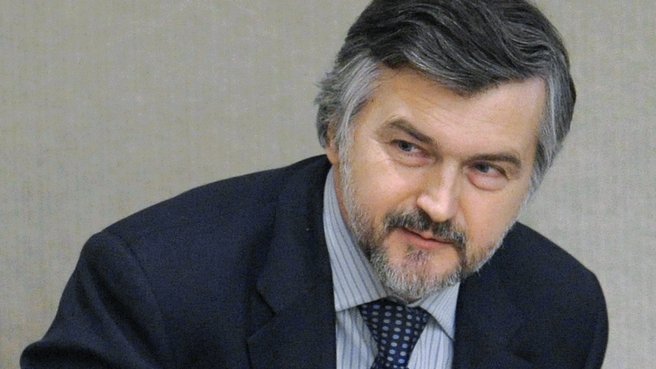Agenda: scenario conditions, main forecast parameters for Russia's socio-economic development and threshold levels of prices (tariffs) for the services of companies in the infrastructure sector in 2014 and in the planning period for 2015 and 2016, plus 9 other issues.
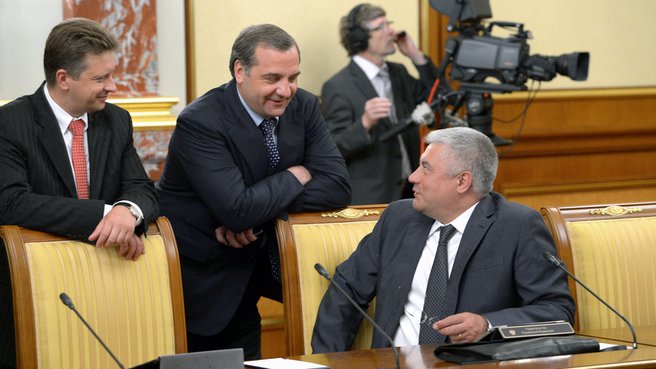
Minister of Transport Maxim Sokolov, Minister of Civil Defence, Emergencies and Disaster Relief Vladimir Puchkov and Minister of the Interior Vladimir Kolokoltsev before the Government meeting
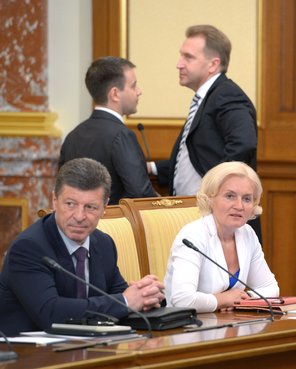
Deputy Prime Minister Dmitry Kozak, Deputy Prime Minister Olga Golodets, Minister of Communications and Mass Media Nikolai Nikiforov and First Deputy Prime Minister Igor Shuvalov before the government meeting

Minister of Civil Defence, Emergencies and Disaster Relief Vladimir Puchkov and Minister Mikhail Abyzov before he Government meeting
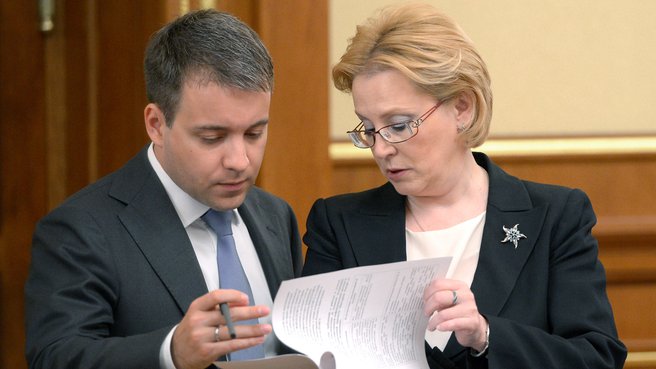
Minister of Communications and Mass Media Nikolai Nikiforov and Minister of Healthcare Veronika Skvortsova before the government meeting
Government meeting
Transcript:
Dmitry Medvedev: Dear colleagues, here are some issues I’d like to begin with: first of all, the budget for the next three years. Let’s start with the scenario for the development of the economy and the social sector. This is based on long-term, until 2030, and mid-term forecasts. This report includes an evaluation of the potential dynamics for key indicators including the gross domestic product, oil prices, the value of the rouble, inflation and investment levels.
Three scenarios have been forecast. Mr Belousov (Andrei Belousov, Economic Development Minister) will explain them. One is conservative, one moderately optimistic, and the third is more aggressive. The ultimate goals are generally the same for all the three. The global economy is expected to begin to gradually recover with an annual growth rate of nearly 4%. The price for Urals crude will be about $100 per barrel. Competition in several energy markets, including the gas market, is increasing, which is also taken into account. The difference in the scenarios is in the strategy of conducting business, and the efficiency of state policies, including limits on budget expenses.
Dmitry Medvedev: Irrespective of which scenario becomes reality, we will continue our efforts to improve the investment climate, to enhance the competitiveness of our businesses, to support high tech sectors and to promote innovations. We must both modernise the social sphere and also make systemic improvements in education, healthcare and research.
Another variable is the demographic situation. Irrespective of which scenario becomes reality, we will continue our efforts to improve the investment climate, to enhance the competitiveness of our businesses, to support high tech sectors and to promote innovations. We must both modernise the social sphere and also make systemic improvements in education, healthcare and research. We also need to build transport infrastructure as much as possible, given our budget and investment opportunities. These are old targets, which we have outlined in government programmes and which we must achieve.
Let’s talk about scenarios. We will need to hold a special discussion to select one of the scenarios as the basis. The Ministry of Economic Development has proposed that we choose the moderately optimistic scenario, but opinions differ and we need to discuss all of them. We will launch discussion here and now, listen to what the experts have to say and exchange opinions.
I’d like to say that the planned increases in infrastructure companies’ prices, including gas, electricity and railway, are in line with approved Government decisions. However, I’d like to remind the Ministry of Economic Development and other agencies that the President’s directive and the subsequent Government instruction, which I signed, stress the importance of restraining the growth and even decreasing the prices of the natural monopolies’ goods and services. We must prepare these proposals and take them into account at the next stage of working on the budget.
Dmitry Medvedev: Planning can only be effective if we forecast changes in the customs sphere and the dynamics of import and export duties, take into account plans for the continued standardisation of customs procedures of (the Customs Union members) Russia, Belarus and Kazakhstan, improve the regulation of customs rates at the supranational level and try to pursue a common trade policy toward other countries.
One more economic issue on our agenda concerns the guidelines of the customs rate policy for 2014-2016, which determines the medium-term conditions for foreign economic operation. Planning can only be effective if we forecast changes in the customs sphere and the dynamics of import and export duties, take into account plans for the continued standardisation of customs procedures of (the Customs Union members) Russia, Belarus and Kazakhstan, improve the regulation of customs rates at the supranational level and try to pursue a common trade policy toward other countries. It goes without saying that we must also honour the obligations which we have assumed within the framework of the World Trade Organisation. I want to say that the level of customs protection for different groups of commodities will be lowered gradually and on a case-by-case basis, in order to help our industries to adapt to the new conditions.
Ultimately, the customs rate policy must enhance the competitiveness of national producers and stimulate the modernisation of the industries that focus on the export of high tech products, including the nuclear power industry, mechanical engineering, microelectronics, biotechnology, and the production of pharmaceuticals and medical equipment. We must protect the external borders of the Customs Union and work together with our partners to minimise the risk of grey imports from other countries. Unfortunately, the volume of such grey imports has been growing, which is very alarming. We will be unable to deal with this problem if we stand alone. Hence, we must address it together with Belarus and Kazakhstan.
We will also discuss the drafts of two federal targeted programmes for the development of science until 2020. Their total financing will be around 440 billion roubles, with the bulk of allocations, 355 billion, to be provided from the federal budget. The minister will report on certain indicators. This should enable us to create a competitive potential and to use it, in part, to implement effective applied research projects and to accumulate an inter-branch research and technology stock in the priority areas. It is equally important to attract young people to research. We have improved the situation with encouraging young researchers to stay, but there is still more to be done.
The first issue concerns scenario conditions. The Minister of Economic Development will present a report.
Andrei Belousov: Mr Medvedev, colleagues.
As has already been said, the development scenarios for the Russian economy up to 2016, which are being discussed today, were compiled on the basis of a long-term forecast and parameters of the three-year forecast which was approved in the autumn of 2012, and which formed the basis of the current law On the Federal Budget. I would like to remind you that, at that time, the Ministry of Economic Development said that economic growth was likely to stall in the first half of the year, and that annual GDP growth rates might not top 3%. Unfortunately, economic growth has fallen even more than was predicted last year. GDP growth has been falling for the last five quarters from about 5% to 1.1% in the first quarter of 2013.
We have already discussed the causes of this falling growth at meetings chaired by the President and the Prime Minister. On the whole, we need to single out two groups of main factors contributing to slower growth and which call for an amended forecast.
First, this includes the suppressed state of the global markets. We have failed to post any export increases in real terms for virtually eight quarters. Nominal export volumes even began to subside from the second quarter of 2012.
Second, we should mention factors to do with domestic monetary policy, primarily high interest rates. These interest rates topped 12% on corporate loans with a duration of over 12 months during the first quarter of 2013. Given a stronger rouble, this considerably reduces the competitiveness of Russian companies and hampers economic activity.
A tougher monetary policy goes hand in hand with a tougher budget policy, especially in the field of investment. Last year, volumes of state capital investment decreased in real terms by about 8%, and they are expected to fall by the same amount in 2013.
The state’s reduced investment activity is complemented by a decrease in volumes of investment by major infrastructure companies by 10% in 2012 and by an estimated 12-13% this year. This primarily concerns the gas sector. I would like to note that overall volumes of government investment and investment by infrastructure companies account for almost 30% of the investment in the economy. Therefore this almost 10% slump means that total investment will fall by about 3%.
These trends have reduced the GDP growth forecast for 2013 from an estimated 3.7% last autumn to 2.4%. However, economic trends must accelerate considerably in order to achieve even this reduced target. We expect that negative trends will be rectified in the second quarter, and that economic growth will be above 3% in the second half of 2013. For instance, the forecast takes into account the effect of the Government’s growth stimulus package, which is currently being drafted.
Changing crude oil price trends are another important factor for revising the 2012 forecast. This year, average estimated oil prices have increased from $97 per barrel to $105, largely as a result of high first-quarter indices this year. In our previous forecasts, we were guided by the assumption that moderate oil price increases would persist during the restoration of global oil demand. Currently, we believe that oil prices will fall in 2014-2016 to around $100 per barrel. Higher estimates for production volumes of low permeable oil, primarily in the United States, will curb oil prices even under conditions of greater global demand. In fact, oil prices are likely to fall to about $80 per barrel. On the whole, we were guided by a coordinated forecast of international organisations and banks, but we opted for a more conservative scenario.
The third factor is the revision of our expectations regarding energy exports as a result of greater supply on global energy markets. This concerns the gas market above all. A considerable expansion in shale gas production in the United States and planned deliveries of shale gas to the European market at the end of the reporting period have reduced gas export estimates by an average of 10% on the 2012 forecast. At the same time, the petroleum export forecast is slightly higher. Given the current trends, we expect that petroleum exports will not stabilise any earlier than 2015.
Fourthly, we have reduced planned annual fixed capital investment trends by about 0.6-0.7%. This reduction is motivated by the following two main factors. First, major companies in the infrastructure sector revised their plans in late 2012. I would like to point out that Gazprom adjusted its 2014-2015 investment programme by about 30%. Companies in the energy sector and the oil transport industry have reduced their investment plans by almost 10%. Second, estimates of state investment have been reduced, which is connected with the incipient fiscal stress of regional budgets and the replacement of investment costs with current spending. At the same time, new resources are expected to be attracted for financing investment projects on a repayment basis, including assets of the National Wealth Fund and pension savings. I would like to remind you that the Supervisory Council of Vnesheconombank and the boards of Russian Railways and the Federal Grid Company (FSK) have already approved the issuing of infrastructure bonds for the purpose of attracting pension savings. The bonds are to be issued in July-August 2013.
The scenario also hinges on the implementation of measures to improve the business environment, which will also improve the investment attractiveness of the Russian economy. Our current hypothesis means that overall investment trends under a moderately optimistic scenario will hinge on the sustained growth of private investment. Private investment is expected to rise by 8-10% in 2014-2016. By the way, I would like to say that, despite certain criticisms of the national business environment, there has so far been no slowdown in volumes of private investment. Reduced investment is primarily linked with a reduction in state investment and investment by companies with state capital.
And, finally, the fifth factor is linked to reductions in estimated increases in consumer spending. The estimated retail trade turnover for 2014-2015 was reduced by almost 1% based on the forecast in September 2012. This is due primarily to a revision of specific trends regarding disposable incomes of the population. A rapid increase in the debt burden of the population with high interest rates for retail lending will start worsening the balance sheets of Russian households and have a major influence on consumption growth. For your information, the debt burden on national households has increased from 10-11% of their incomes in 2007-2008 to 14% in 2012 and to 17% in 2013. The related interest payments have increased from 2% to 3.5%, which is almost by half.
Consequently, average annual GDP growth rates for 2014-2015 have been reduced from 4.4% to just under 4%. We expect 2014 economic trends to reach 2012 levels (3.7%) and to reach 4% and higher in 2015-2016.
The main contribution to GDP growth will come from rises in consumer spending. Retail trade turnover and disposable incomes will rise by about 5% annually over the next three years, and they will account for over 50% of GDP growth.
We also expect investment demand to gain momentum from 2014, after measures to improve the investment climate start to produce results. The annual rise in investment is set to increase from 4.6% this year to 7-8% in 2015-2016. And the rate of capital accumulation will increase from the current 21% of GDP to over 24% in 2016. On the whole, investment will make up about 40% of GDP growth.
And, finally, measures to support exports are expected to produce results. We expect real exports to increase from 2014, but this quite modest increase will not exceed 2%, and it will be hampered by the lack of potential for boosting fuel exports. At the same time, machinery and equipment exports should increase by up to 7% in 2014-2015.
Apart from the main, moderately optimistic scenario, we assessed two other forecasts. Under the conservative scenario, conservative trends and an austere monetary policy will persist, and annual rates of economic growth will be about 3%. And the forced scenario sets out active improvements in the business climate, institutional changes in the education, healthcare and housing sectors, as well as the implementation of large-scale transport and high-tech projects. In this case we can expect mid-term growth rates at over 6%.
Our priority should definitely be to focus on achieving economic growth under the forced scenario. But we suggest using a more conservative and moderately optimistic scenario, which, incidentally, completely takes account of the budget rule to draft budget estimates. Additional measures have to be implemented in order to speed up economic growth and to achieve the targets of the main scenario. I would like to stress once again that this task is quite important in the context of the current situation. Furthermore, it is important that we draft specific measures and start implementing them today in order to be able to switch to the rapid economic development scenario.
As part of the Government instruction, the Ministry of Economic Development has drafted an action plan to enable the country's economic growth rates to accelerate. The plan includes measures to reduce interest rates and to increase the availability of affordable loans. In our estimate, annual corporate loans should increase by at least 16-18% in 2013-2016.
We also believe that putting caps on the prices and tariffs of the goods and services of natural monopolies can provide a boost to production. As Mr Medvedev has said, the relevant instructions have been issued by the President and the Prime Minister, but I would like you to note that tariffs have not been revised in the framework of the original scenario. We deem it necessary to take a close look at all the possible consequences of restrictions on their growth (taking into account, among other things, the investment programmes of infrastructure companies which have now been revised downward) and adopt an updated version of the forecast in September. This means measures to improve the business climate, speed up the implementation of the National Entrepreneurial Initiative, and support export and small business. A separate group consists of measures to improve the management of companies with state participation involving the introduction of the best corporate governance practices and systems of performance-based incentives for managers.
The implementation of systemically important projects is a key element in ensuring the rate and quality of economic growth. The scenario contains a list of projects that have a significant structural impact. They are aimed not only at supporting the development of the relevant sectors, but at creating new growth points in related sectors. Key projects in the transport field include the building of a high-speed railway between Moscow and Kazan, the elimination of bottlenecks on the approaches to Far Eastern ports, increasing the capacity of the Trans-Siberian Railway and the Baikal-Amur Mainline, the development of the Moscow transport hub and the network of motorways.
Projects of systemic importance also include the development of high-tech production, such as projects to develop the rare earth metal industry, the scientific and industrial potential in the field of composite materials and nano-structured ceramics. There are also a number of projects in sectors aimed at developing the human capital and the knowledge-based economy.
The total need for state financing of key projects is estimated at 0.5-0.8% of the GDP. These projects are expected to be financed both through private and public funds, and that does not only mean the federal budget. It also involves resources of the National Well-Being Fund and accumulated pensions, which will be compensated for later.
In conclusion I would like to repeat that the measures mentioned will ensure the targeted growth of the economy and the quality of life. These parametres are realistic, but they call for vigorous action, and a concentrated effort to implement the measures aimed at speeding up and balancing development. I propose adopting a moderately optimistic forecast as the basis for calculating the budget parameters for 2014-2016. Thank you.
Dmitry Medvedev: Thank you.
<…>
***
Following a Government meeting Deputy Minister of Economic Development Andrei Klepach replied to questions by journalists
Question: Have the Minister’s proposals on the forecast scenario been endorsed? And a second question: could you perhaps tell us about what was discussed behind closed doors?
Andrei Klepach: The second variant or moderately positive forecast has been endorsed as the main scenario for drafting the budget for 2014–2016. The Minister said there is a risk that we may follow the bottom trajectory. I’m referring to the conservative variant which predicts an average growth of about 3% during this period. At the same time, to fulfill the President’s executive orders and implement to the utmost the socio-economic tasks set forth in the Policy Priorities of the Government, we must strive for the third variant, or intensified growth. But the budget is a conservative thing, and so we have decided to approve the second version – the moderately optimistic or moderately conservative version – whatever term you prefer.
Speaking about the closed part of the meeting, we discussed the same issues as in the open one, but perhaps we focused more on the ways of reaching the goals set forth in the forecast. The Minister said even the moderately optimistic forecast… that is, the reversal of the trends towards slower growth and even a certain acceleration requires the implementation of a package of measures, and not only the one that is currently being drafted. When we worked on the forecast and made a long-term forecast last year, we programmed into it an ideology of certain reforms that should guarantee a higher trajectory of economic growth and should allow us to overcome the inertia of the current slowdown.
Now this is also tailored to the elaboration of an action plan. The Government has already discussed its draft version and it is being polished up now. There are a few points. There are some goals on which everyone agrees, and there are nuances and differences on the ways of reaching them. As for the package of issues on improving the investment climate, there are no differences at all. It is difficult to find a person who would object to the improvement of the investment climate or the business environment. It all boils down to what results these or other measures will produce. Although we are used to saying that our investment climate is not very good and we are displeased with it (this is a truism), there are some indicators showing that not everything is so bad. Despite the big capital drain through the banking system in the first quarter of this year when banks are accumulating their assets, and the transfer of funds abroad by small companies, we were receiving a fairly steady flow of direct foreign investment. This shows that our economy is attractive.
Second, the slowdown in the flow of investment and the low growth rates in the first quarter, and even the reduction of the forecast for this year (the lowest level is 3% and our main version is 4.6%), are linked with the reduction of state investment and real investment of some public companies – Gazprom and electricity providers.
As for the investment of private business as such, we expect it to grow substantially both this year (about 6%-7%) and in the next few years. In other words, private investment will more than compensate for the decrease in the public or quasi-public sector.
Now I’d like to say a few words about the business climate. The second problem that is also very urgent is the high interest rates. These rates are currently at about 12% on loans for more than one year. If we take into account not only current inflation, which is over 7%, but also what we expect by the end of the year (and loans are taken for more than a year) – about 6% and most likely less... This means that interest rates in real terms are already higher than 6% and they are continuing to grow. Naturally, this is a serious barrier for business. What should we do about this and how should we build our fiscal policy? The Minister said we should create conditions for a serious increase in the money supply and for fairly high growth rates in the issue of loans to the non-fiscal sector – at least 16%-18% and better 20%. This is much higher than what we had last year – from December to December the issue of loans to the non-fiscal sector grew by about 12%. In other words, our market has different trends – on the one hand, we have fairly high growth rates, extremely high growth rates in the issue of loans to the public, and this is where the money goes, including the funds that people deposit in banks. And on the other hand, there are very low growth rates in the granting of loans to the economy. Therefore, it is necessary to find ways (there are disputes here) of reaching the goal on which everything agrees – to create conditions for reducing interest rates (the Central Bank plays the main role here). For this reason certain adjustments and amendments in fiscal policy have been programmed into the forecast or scenario conditions that the Government has now approved and about which the Minister has reported.
The third issue (mentioned in the speech and discussed later) is as follows: to speed up the economic growth we will probably have to adjust the policy of tariffs in the economy’s infrastructure sectors. I’m referring to the natural monopolies, as they are often called, although this is not quite correct. They have both deregulated and monopoly segments. At any rate, tariffs on gas, electricity and heat for the public that are being regulated, the general streamlining of the electric power market, railway tariffs… Today, the Government-approved scenario conditions are based on the tariff policy that was adopted last year for three years into the future. It provides for fairly high growth of gas tariffs, which determine utility fees and payments for electricity. The work on this issue has not been completed. The President has made an instruction on this score and the Government is working on this. We have certain approaches and proposals. They are aimed at slowing down the growth of tariffs, but in 2014 and further on, rather than 2013. But we should not zig and zag. We must have certain steady rules for the operation of Gazprom, and energy and electric companies. We must not invent new rules and changes every year. That said, we are fairly close to the United States in terms of domestic gas prices. We must make some adjustments but in a way that will not affect the investment programmes of Gazprom and electricity providers. These adjustments should set correct guidelines for the market, inter-fuel competition and the effective use of natural resources. We must do this work and will have to submit the first proposals on Monday, but apparently it will take more time and must be synchronised with the drafting of the forecast that the Government will review in September. This is the second package of issues.
The third one did not arouse many disputes. A package of projects that are tailored to the Government-endorsed state programmes, and that sometimes exceed them, was submitted as an appendix to the scenario conditions presented to the Government. One example is a project on high speed railways. It is not part of the current state programme on infrastructure development but we think it will play a key role in shaping a new model not only for railways but also for the entire transport infrastructure. It is necessary to make decisions on these projects. In effect, the scenario conditions take into account the effect that their launch will produce. As for funding, this will be part of the work on the current budget cycle and the drafting of a full comprehensive forecast by September. We do believe that it is impossible to speed up economic growth rates without launching serious national or macro-economic projects.
Question: Mr Klepach, it was believed earlier that the moderately optimistic scenario provided for a less vigorous fiscal policy than the conservative scenario. Have there been any preliminary assessments of the budget deficit for 2013 and for the period to 2016? Have they remain unchanged at 0.8, 0.2 and zero in 2015 and undetermined for 2016, or have there been any adjustments announced?
Andrei Klepach: My answer will be brief: no, there haven’t been any adjustments.
Question: Do you happen to have any preliminary calculations regarding the budget deficit, which are needed for the implementation of ... Not actually the deficit, but the forecast for budget expenditure, because yesterday Mr Siluanov (Anton Siluanov, Minister of Finance) said in the State Duma that increased spending is not possible in 2013-2015. Does the moderately optimistic scenario assume that the budget expenses will not be increased as compared to what was approved before?
Andrei Klepach: We plan to promote growth as real investment expenses are cut... The Ministry of Finance says that this should be a priority. It’s not possible to grow the economy as real investment expenses related to capital expenditure, research, and promoting human capital, are declining. These expenses should grow, but at the same time, we are keeping in mind that we have a fiscal rule that the Government has adopted and doesn’t plan to change.
We will look into ways to find a compromise and restructure costs during the current budget cycle. One of the elements of this compromise is that the co-financing of the priority national projects or the strategically important macroeconomic projects will come largely from the National Wealth Fund and will make partial use of the funded part of the pension system. This imposes fairly strict constraints, because, first, these funds will have to be repaid. Speaking about the NWF, there’s no agreement on the price for using them to finance these projects. However, it should be such as to make these projects pay back their investment within at least 15-20 years. Speaking about the funded pension, the return on its investment is still significantly above the inflation rate (about 9%), which also imposes severe limitations. The estimated financing requirement for GDP funds is around 0.5%-0.6% of GDP in the near future.
Question: Speaking at a Government meeting, Minister Belousov said the economy has been slowing, from 5% to 1.2% (in the first quarter), for five consecutive quarters and then said that the negative trend will reverse in the second quarter, and the economy will be up 3% by the end of the first six months. It’s not entirely clear why there is such an abrupt transition to optimism?
Andrei Klepach: First of all, I don’t see any sharp transition to optimism here. Everything in life can be seen from different angles. The forecast that was made in 2012 and in 2013 was based on the assumption that growth will slow down in the first and second quarter. Frankly, back then we expected about 2% year-to-year, but now we have 1.1% in the first quarter. Things will improve in the second half of the year.
The assumption of accelerated growth was based on the following. First, our exports have been declining for almost two years now, first in real terms and now in nominal terms as well. We expected exports to pick up in the second half of 2013, not only that of hydrocarbons, but also exports of raw materials, which corresponds to the fact that the Chinese economy will grow fairly steadily. The assessments of its growth are rising, and are even higher than provided by our forecast. The European economy will come alive in the second half of 2013 as well, in line with forecasts made by the OECD and the European Union.
Second, we assumed that we would manage to reverse the situation with interest rates and lending to the corporate sector, which provide give further impetus to an increase in investment and accelerated growth.
Third, also important, but perhaps intangible, is a matter of trust and credibility. We assumed that the increasing uncertainty in the behaviour of businesses that we saw last year and this year related to the global economic risks and the next steps of the Government will decrease when global risks subside and the Government shows what it will actually do to implement the Policy Priorities. The scenario approved by the Government is also a step in this direction. Further steps are related to road maps and plans on the part of the departments regarding the implementation of the presidential executive order to improve the business climate and decide on the situation with taxes and tariffs within the next few months.
Question: Mr Belousov said that the Ministry has adopted a plan to stimulate economic growth. As we know, there’s a Government report to that effect which was submitted to the President yesterday. It is not clear which proposals made by the Ministry of Economic Development were included in this general Government report which was submitted to Mr Putin . Have all the points that Minister Belousov made today been included? What has the Ministry of Finance proposed?
Andrei Klepach: First, the Ministry does not approve the plan to accelerate economic growth. If our Ministry could speed up or slow down economic growth, we would be above competition with other ministries. We have submitted the draft plan, and we have, in fact, discussed it at a Government meeting. I have no way of knowing whether the report was submitted to the President, you’ll know about it earlier than I. Therefore, I don’t know what's left in it and what was removed from it.
Question: There’s information that the Central Bank proposes that the Government set an inflation target at 4.5% for the next two to three years with a possible deviation of 1.5 percentage points. What do you think about this proposal? Do you support it? That’s my first question. The second question is: How are things with inflation? What’s your forecast for May? Will inflation be lower than in April?
Andrei Klepach: In fact, the current inflation forecast almost fits into this level, because for 2014 and beyond we had inflation at 4.5%, so there’s no contradiction.
It’s too early to be able to say whether we’ll stay within 4.5%. The 4% - 5% range is quite likely, and this is what we have in our forecast and budget calculations.
The key issue is not monetary policy, because the monetary supply fell hard enough, and, if I remember correctly, this year’s benchmark is between 9% and 10% . If we take the monetary base in narrow terms, which is enough, or at least consistent with this inflation target, then the risks will be associated with the future exchange rate policy, and, to a greater extent, on the developments on the global food market. The trend has been favourable here so far, and in line with our expectations. However, the situation nay change overnight as we saw in 2010 and earlier; therefore, inflation depends not only on the Central Bank and its monetary policy.
Question: What about for May?
Andrei Klepach: We proceeded based on the assumption that inflation would be higher in April and May, perhaps, 0.5% or even 0.6%, due to seasonality, and would continue to decline more sharply afterwards.
Question: About a month ago, when the scenario was made public, the Minister said that with the current trend in place and in the absence of incentives, a recession may start already in the fall. Since there are no signs of trend reversal in sight, and since the Central Bank kept the base rate unchanged and the fiscal rule has been maintained, will the risks of a recession increase in the fall or afterwards?
Andrei Klepach: That’s what risks are all about: there’s a chance that it could happen. In our scenario that was submitted to the Government, we never talked about that ... I mean, there are risks, but this is an unlikely scenario.
In order to head off the recession in Russia, we need a shock or even a negative shock on behalf of the global economy. Even though stagnation is continuing in the euro area, we expect the situation to improve in the second half of 2013, although we realise that the euro area will continue to fight its illness for a long time. Under these circumstances, a recession, that is, zero or negative GDP growth, is unlikely. However, stagnation or slow growth is a serious threat for us. Growth rates of 1.7%, or 2% mean that we will lose our competitiveness. We may be growing faster than the euro area, but we will lag way behind our neighbours, such as China and other countries. Low growth rates mean that there’s no revenue to invest and promote education, conduct research, build roads and form the budget revenue. Therefore, such a development is a lose-lose for us, and is therefore inadmissible.
Question: A few clarifying questions, if I may. First, concerning tariffs. You are saying, let’s not be jumpy. Do I understand correctly that zero growth rates for individual industries are not even being considered? The second question: have you decided on the proposals from the plan to stimulate economic growth that you feel should be included here?
Andrei Klepach: There were different proposals, including freesing the tariffs. However we agreed that in 2013 we would not change the parametres of growth in tariffs that the Government approved in 2012. We believe that the tariffs in 2014-2016 will change significantly. It’s too early to talk about how. There are different approaches. Moreover, even if we take the netback model (net production value) for gas prices, it is quite sensitive to the world prices and the exchange rate. If global prices decline, then the domestic price for gas should decline, not increase. So, we need to tweak certain things in order to stabilise the situation.
The risk that oil and gas prices will be lower than what we have in the forecast is fairly significant. Therefore, along with the basic scenario, we have a scenario in which the price of oil is about $80. Accordingly, the price for gas will be significantly lower as well. Then we will reach the level of Germany or close to it in terms of netback. Thus, all these issues need to be considered.
It’s too early to talk about the details of these measures, because they haven’t yet been adopted. However, they include proposals aimed at improving the investment climate both in terms of institutions and putting together proposals for tariff adjustments. Part of these measures has to do with reducing the cost of money. Different departments have different approaches, so we’ll need to perform an analysis and do some work to identify costs of bringing rates down. Since these are market rates, they are not defined by the Government or even the Central Bank. Different tools are at play here.
There’s a list of these projects. There are proposals to amend regulations in order to invest NWF funds. We should also identify criteria for selecting investment projects. In addition, there are proposals to improve corporate governance and KPI of the management. In this case, the state can implement it only for the companies with state participation. This is also a significant portion of the sector, because enhanced business efficiency and effectiveness is, in the long run, the most important thing, and state-owned companies should be the standard of efficiency and corporate strategic behaviour.
Question: I would like to clarify one thing: do I understand correctly that the final decisions have been made for 2013, and nothing will change in terms of tariffs?
Andrei Klepach: Like pilots say: there’s no final decision, only the latest decision. So, the latest Government decision is that we will proceed in 2013 based on the adopted tariffs in 2013. I believe I stated that quite clearly.
